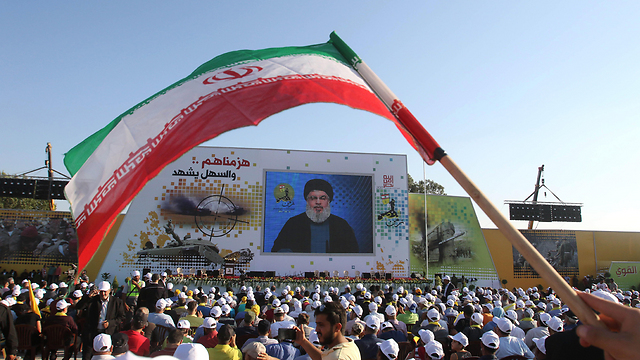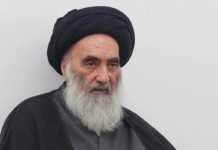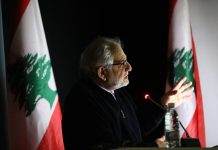The Lists of ‘Hezbollah’
Abdulrahman Al-Rashed/Asharq Al-Awsat/May 18/2018
Six Hezbollah leaders are now on the terror lists of six Gulf countries and the United States. The importance of this issue lies also in its background.
In this month last year, the International Center for the Targeting of Terrorist Financing was inaugurated following the memorandum of understanding signed between the Gulf states and the United States in Riyadh during the visit of President Donald Trump.
Last May during US President Donald Trump’s visit to Riyadh, the Terrorist Financing Targeting Center was inaugurated after a memorandum of understanding was signed between Gulf states and the US.
It is true that these six people listed do not have Saudi or Gulf bank accounts and do not visit these countries, not even the US, but blacklisting them is part of a confrontation policy that aims at curbing Iran and its proxies in the region.
Before this announcement was made, the activity of financial institutions detected in the UAE was halted because they were transferring money to Iran. A few days before that, the al-Bilad Islamic Bank in Iraq was blacklisted according to a statement issued by the US Treasury which is a member of the International Center.
Listing six Hezbollah leaders can be seen as a move that distinguishes between Lebanon and Hezbollah although the latter always seeks to combine these two entities and make the six million hostages in the country pay the price for any punishment imposed on it.
The coordination between the seven countries against Iran’s activities is relatively old but it has become stronger after the US withdrawal from the nuclear deal as Washington has actually engaged in the economic sanctions that were suspended in the last three years.
Iran has arms and militias and it is involved in fighting in a number of countries in the region and outside of it. However, we do not want opposing countries to pursue this same approach of spreading violence.
The weapons that these opposing countries and their allies use are economic, technical and informational. After Washington announced reimposing economic sanctions, the Iranian currency dropped to a point of collapse. Between these two weapons and war tactics, the Iranian government’s crisis will be more dangerous than that of opposing countries.
Those who criticize what they view as failure of the countries of the region of not confronting Iran through violence and war may not realize that facing it through economy and boycotts in partnership with major countries is more beneficial. Iran mainly relies on its oil revenues to fund its wars in Syria and Yemen and it funds Hezbollah with around $700 million a year.
It pays most of the budgets of the Hamas Movement in Gaza and the Houthi Movement in Yemen. Except for Syria, the Iranian army and Revolutionary Guards do not directly engage in fighting but they send money, arms and recruiters. Therefore, we are on the brink of a different war.
قوائم «حزب الله»
عبد الرحمن الراشد/الشرق الأوسط/18 أيار/18
ستة من قادة «حزب الله» أصبحوا على القوائم المحظورة في ست دول خليجية وأميركا. خلفية الموضوع مهمة أيضاً.
ففي مثل هذا الشهر من العام الماضي افتتح المركز الدولي لاستهداف تمويل الإرهاب، في أعقاب مذكرة التفاهم الموقعة بين دول الخليج والولايات المتحدة في الرياض أثناء زيارة الرئيس دونالد ترمب.
صحيح أن الستة المحظورين لا يملكون حسابات بنكية سعودية أو غيرها من دول الخليج ولا يزورونها، ولا حتى الولايات المتحدة، إنما الحظر هو جزء من سياسة مواجهة تهدف إلى التضييق على إيران ووكلائها في المنطقة.
وسبق إعلان القائمة السوداء هذه إعلان وقف نشاطات مؤسسات مالية رصدت في الإمارات كانت تحول الأموال إلى إيران، وكذلك قبل أيام قليلة تم وضع بنك البلاد العراقي على القائمة المحظورة، وفق بيان من وزارة الخزانة الأميركية التي هي أيضاً عضو في المركز الدولي.
ويمكن أن ننظر إلى قائمة الستة من «حزب الله» على أنها تعبر عن التفريق بين لبنان و«حزب الله»، رغم أن الحزب يسعى دائماً إلى الجمع بين الكيانين وجعل ستة ملايين رهينة يدفعون ثمن أي عقوبات توقع به.
التنسيق القائم بين الدول السبع ضد نشاطات إيران قديم نسبياً، لكنه أصبح أقوى بعد إلغاء الالتزام الأميركي بالاتفاقية النووية، حيث إن واشنطن انخرطت فعلياً في العقوبات الاقتصادية التي توقفت خلال السنوات الثلاث الماضية.
إيران تملك السلاح والميليشيات وتنخرط في القتال في عدد من دول المنطقة وخارجها، وفي مقابل هذا لا نريد الدول المضادة أن تدخل معها على المستوى والأسلوب نفسهما في نشر العنف. هذه الدول مع كثير من الدول الحليفة الأخرى أسلحتها اقتصادية وتقنية ومعلوماتية. ما تتعرض له العملة الإيرانية من شبه انهيار في سعرها جاء بعد إعلان واشنطن تفعيلها العقوبات الاقتصادية. بين السلاحين والحربين سنرى الحكومة الإيرانية في أزمة خطيرة أكثر من الدول التي تعاديها.
والذين ينتقدون عادة ما يعتبرونه تخاذل دول المنطقة وأن عليها أن تواجه إيران بسلاحها، سلاح العنف والحرب، قد لا يدركون أن سلاح الاقتصاد والمقاطعة بمشاركة دول كبرى هو أنجع وأمضى. فإيران تعتمد بشكل أساسي على مداخيلها النفطية بتمويل حروبها في سوريا واليمن، وهي تتولى تمويل «حزب الله» بنحو سبعمائة مليون دولار سنوياً، وتدفع معظم ميزانيات تنظيمي «حماس» في غزة والحوثي في اليمن. باستثناء سوريا فإن الجيش والحرس الثوري الإيرانيين لا يقاتلان مباشرة. يرسلان المال والسلاح والمدربين، وبالتالي نحن على أبواب حرب مختلفة.






















